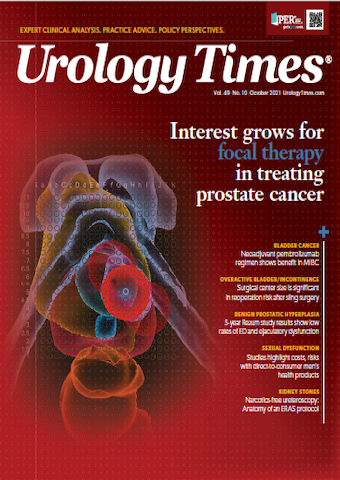Publication
Article
Urology Times Journal
Active surveillance for prostate cancer is generally safe, study results show
Author(s):
"This large cohort study confirms the safety of AS, as shown in the low rate of metastasis or death, including those who subsequently converted to treatment," writes Badar M. Mian, MD.
Badar M. Mian, MD

Active surveillance (AS) for the management of low-risk prostate cancer is slowly becoming the de facto standard of care. Although the adoption of AS has been increasing, still too many patients with low-risk prostate cancer appear to be undergoing active treatment. A frequently voiced concern by patients and physicians alike is the risk of disease progression and the need for active treatment. These issues were addressed in the recent study by Cooley et al of a large, multicenter cohort of men converting from AS to active treatment.
The investigators evaluated the clinical and pathologic parameters associated with the time to conversion from AS to treatment in the pooled cohort of 7279 patients from 28 institutions between 1991 and 2018. They also evaluated the association of germline genetic variants to conversion to treatment in a subset of patients. The primary question to be addressed was the time from prostate cancer diagnosis to conversion to treatment. Those men followed without a strict AS protocol were analyzed in the same manner as those on AS.
The patients were stratified into risk groups. Low-risk patients were Gleason grade group (GG) 1 (Gleason score 3+3) and had prostate-specific antigen (PSA) lower than 10 ng/mL, clinical-stage cT1, and 2 or fewer positive biopsy cores. Intermediate-risk patients were GG2 (Gleason 3+4) and had PSA 10 to 20 ng/mL, stage cT2, or 3 positive biopsy cores of any Gleason grade. High-risk patients were GG3 or higher and had cT3 or 4 positive cores of any GG.
The investigators compared low-volume GG1, high-volume GG1 (≥ 4 biopsy cores involved), intermediate-risk, and high-risk patients. Also, exploratory subgroup analysis including self-reported race and genetically-inferred ancestry was performed for time to conversion. The genetic inference was obtained from patient data of uncorrelated single nucleotide polymorphisms that were available for a subset of patients.
Of the 6775 men meeting the inclusion criteria, median PSA was 5.0 ng/mL, and GG1 was noted in 91.6%, stage cT1 in 79.5%, 1 to 2 positive biopsy cores in 77.6% of patients. There were 882 men (13.0%) who had some higher-risk features such as GG ≥ 3 (1.2%), cT3 (0.7%) or 4 or more positive cores of any GG (11.3%).
The median follow-up for the entire cohort was 6.7 years, during which 33.4% of men converted to treatment. The median time to conversion was 6.8, 6.1, and 7.0 years for low-, intermediate-, and high-risk/high-volume disease, respectively. The most common reasons for conversion were grade reclassification alone (48.8%), PSA progression (8.5%), tumor volume progression (7.2%), anxiety (5.0%), and other (9.0%). Of the men who died, less than 1% died of prostate cancer, whereas 1.3% died of other competing cause.
Multivariable analysis, including the self-reported race, demonstrated that higher GG, PSA, clinical tumor stage, number of positive biopsy cores, and more recent year of diagnosis were significantly associated with earlier time to conversion. Men with high-volume, 4 or more GG1 cores were more likely than those with 3 or fewer GG1 cores to convert to treatment (63.6% vs 26.0%). Further, the conversion rate was higher than those with intermediate-risk disease (63.6% vs 38.3%), but similar to men with other higher-risk features (63.6% vs 65.7%). Men with high-volume GG1 converted to treatment sooner than patients with low-volume GG1 (aHR 3.46, 95% CI: 2.92-4.10). The risk for conversion was higher than the intermediate-risk patients (aHR 1.78, 95% CI: 1.59-1.99) and similar to all other high-risk patients.
Age, race, and a positive family history of prostate cancer were not associated with the time to conversion. There was no difference in the time to conversion between Black and White men across various risk groups. Further, none of the genetic ancestry groups had a shorter time to conversion to treatment. Conversion to treatment was noted in 2260 men (1107 prostatectomy, 565 radiotherapy, and 588 other treatments), of whom 124 (5.5%) subsequently developed a PSA recurrence, 29 (1.3%) developed metastasis, and 11 (<1%) died of prostate cancer.
This study included patients from 28 centers to provide an analysis of more representative practice patterns. However, the attempt to assemble a large “real-world” cohort also may have introduced substantial heterogeneity that could confound the results and make it difficult to identify the most effective strategy. Some sites likely used watchful waiting instead of a strictly defined AS protocol. The intervals for PSA testing and biopsy are not available. Additionally, the data on comorbidity, life expectancy, and exact triggers for conversion to treatment were not provided.
The higher rate of conversion to treatment for men with 4 cores of GG1 than those with 3 or fewer cores GG1 or intermediate-risk prostate cancer is not surprising. When starting at a higher volume of cancer, one is likely to arrive at the arbitrary threshold (PSA, grade, volume) for intervention earlier. The most common triggers for treatment in this AS cohort were changes in Gleason grade or PSA or positive cores. It is important to consider that conversion to treatment (based on higher tumor volume or PSA) is not necessarily the biologic destiny of these cancers but likely an epiphenomenon related to the treating urologists’ understanding or concern over those changes. Does a change in positive cores with GG1 from 3 to 4 cores or an increase in PSA alone portend a poor prognosis? Does the conversion to treatment due to anxiety represent a missed opportunity for proper counseling to avoid unnecessary treatment?
This large cohort study confirms the safety of AS, as shown in the low rate of metastasis or death, including those who subsequently converted to treatment. The 33% rate of conversion to treatment (for any reasons) is not a failure of the AS strategy, but rather a success since two-thirds of patients were safely spared any treatment for over 7 years. Now, with the incorporation of prostate MRI or genomic tests, patients and urologists can feel more confident in the use of AS to safely avoid unnecessary treatment.
Reference
1. Cooley LF, Emeka AA, Meyers TJ, et al. Factors associated with time to conversion from active surveillance to treatment for prostate cancer in a multi-institutional cohort. J Urol. Published online August 16, 2021. doi:10.1097/JU.0000000000001937























